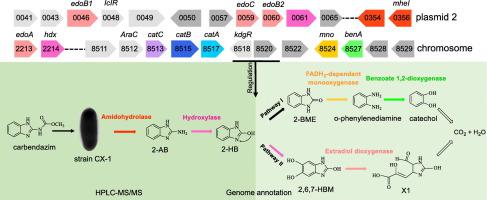Science of the Total Environment ( IF 8.2 ) Pub Date : 2020-09-01 , DOI: 10.1016/j.scitotenv.2020.142137 Zhengnan Long 1 , Xiuguo Wang 2 , Yingjun Wang 3 , Huawei Dai 3 , Changhao Li 3 , Yongfei Xue 1 , Yanfei Deng 1 , Houpu Zhang 1 , Yunlong Yu 4 , Hua Fang 4

|
The persistence and ecotoxicity of carbendazim residues pose a potential risk to environmental ecology and human health. Here, a novel and highly efficient carbendazim-degrading bacterium Rhodococcus sp. CX-1, capable of utilizing carbendazim as its sole source of carbon and energy, was isolated from contaminated soil. The biodegradation characteristics and metabolic pathways were studied by mass spectrometry, genomic annotation, and transcriptome analysis. The degradation rate of carbendazim by strain CX-1 was 3.98–9.90 mg/L/h under different conditions, and the optimum degradation conditions were 40 °C and pH 7.0. The addition of carbon sources (glucose, fructose, and sucrose, 100 mg/L) could accelerate carbendazim degradation. HPLC-MS/MS identification suggested that carbendazim is first hydrolyzed into 2-aminobenzimidazole and then to 2-hydroxybenzimidazole, and is ultimately mineralized to carbon dioxide. The genome of strain CX-1 contained 6,511,628 bp nucleotides, 2 linear plasmids, 2 circular plasmids, and 6437 protein coding genes. Genome annotation and transcriptome analysis indicated that carbendazim degradation may be regulated by the degradation genes harbored in the chromosome and in plasmid 2, and two different degradation pathways of carbendazim by imidazole ring cleavage or benzene ring cleavage were predicted. This study provided new insight to reveal the biodegradation mechanism of carbendazim; furthermore, strain CX-1 is a promising bioresource for carbendazim bioremediation.
中文翻译:

新型多菌灵降解菌株Rhodococcus sp的鉴定。基因组和转录组分析揭示了CX-1。
多菌灵残留物的持久性和生态毒性对环境生态和人类健康构成潜在风险。在这里,一种新型的高效多菌灵降解细菌红球菌sp。从污染土壤中分离出能够利用多菌灵作为其唯一碳和能量来源的CX-1。通过质谱,基因组注释和转录组分析研究了生物降解特性和代谢途径。在不同条件下,CX-1菌株对多菌灵的降解率为3.98–9.90 mg / L / h,最佳降解条件为40°C和pH 7.0。碳源(葡萄糖,果糖和蔗糖,100 mg / L)的添加可以加速多菌灵的降解。HPLC-MS / MS鉴定表明,多菌灵先被水解为2-氨基苯并咪唑,然后水解为2-羟基苯并咪唑,最终矿化为二氧化碳。CX-1菌株的基因组包含6,511,628 bp核苷酸,2个线性质粒,2个环状质粒和6437个蛋白质编码基因。基因组注释和转录组分析表明,多菌灵的降解可能受到染色体和质粒2中所含降解基因的调控,并预测了咪唑环裂解或苯环裂解的多菌灵的两种不同降解途径。该研究为揭示多菌灵的生物降解机理提供了新的见解。此外,菌株CX-1是多菌灵生物修复的有前途的生物资源。











































 京公网安备 11010802027423号
京公网安备 11010802027423号